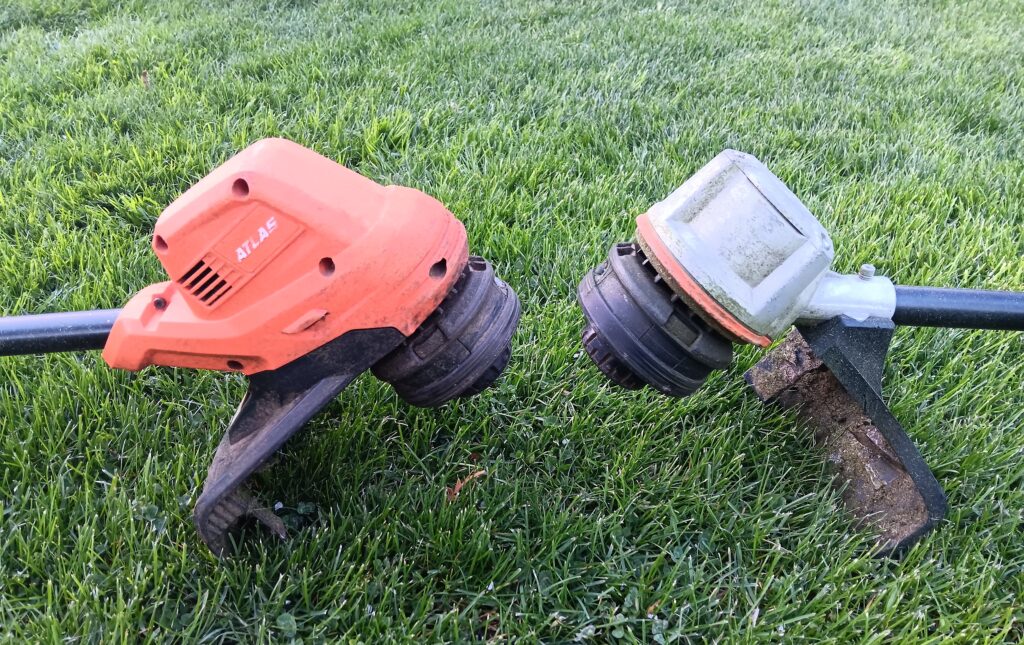
Placed head-to-head the larger 40-volt trimmer looks like it could be the more powerful trimmer, but the performance win goes to the 80-volt overall.
0.095 > 0.080
We have enjoyed our 40-volt Atlas string trimmer for a few years now and it still performs as good as new. However, it only takes 0.08 string which has proven to be a little too weak for the amount we use it. As mentioned in our One Season Review article, the 40-volt trimmer was our first purchase in the Atlas line of outdoor tools and was intended for lighter trimming tasks but has been doing all the trimming since we got it. The only “gripe” is the smaller diameter string breaks easier than larger diameter string and requires more string loading.

The numbers may not seem like much, but the percentage difference in the string’s diameter is about the same as a nickel’s diameter compared to a dime’s diameter. The 0.095″ string diameter is almost 19% larger than the 0.080″ string.
Recently I walked into our local Harbor Freight and was greeted by an open box 80-volt trimmer at a nicely discounted price. It wasn’t a complete impulse buy as the more powerful unit had been creeping into my thoughts. Once home I did an initial function check and tested it with a little trimming to make sure there were no issues. Weight was about the same overall, but balance was not. However, the real test came when my wife got her hands on it.

Shortly after we got the 80-volt trimmer my wife tried it out. I was at work and got this text. She liked it.
The biggest reason for her appreciation of this trimmer is how much longer the string lasts compared to the smaller diameter string of the 40-volt. Both the 80-volt and 40-volt Atlas trimmers have performed flawlessly and handle all the rural trimming tasks we’ve used them for. The biggest advantage of the 80-volt over the 40-volt is the fact that it uses the larger, and more durable, 0.095 diameter string.
One other consideration which we did not explore in-depth are the various brands of string and which, if any, are the better and more durable choice. But, for the brands we have tried the larger diameter string is noticeably more durable.
Power and Performance

Perhaps it’s the additional power of the 80-volt trimmer that allows the larger diameter string. It is simply a more powerful unit and designed to handle the tasks we need a trimmer for. It definitely sounds more powerful as well. However, with the smaller diameter string the 40-volt motor perhaps has less work to do in spinning the string and also performs well as it cuts about everything in its path that it should.
It should be noted that the 40-volt trimmer performs better with the 80-volt battery than it does with the 40-volt battery. Not just in runtime but it seems to have more power as well. We’ve noticed the same in our 40-volt Atlas chainsaw. So, in terms of power and performance I would rank them as follows:
- 80-volt trimmer
- 40-volt trimmer with 80-volt battery
- 40-volt trimmer with 40-volt battery
Trimmer Personalities
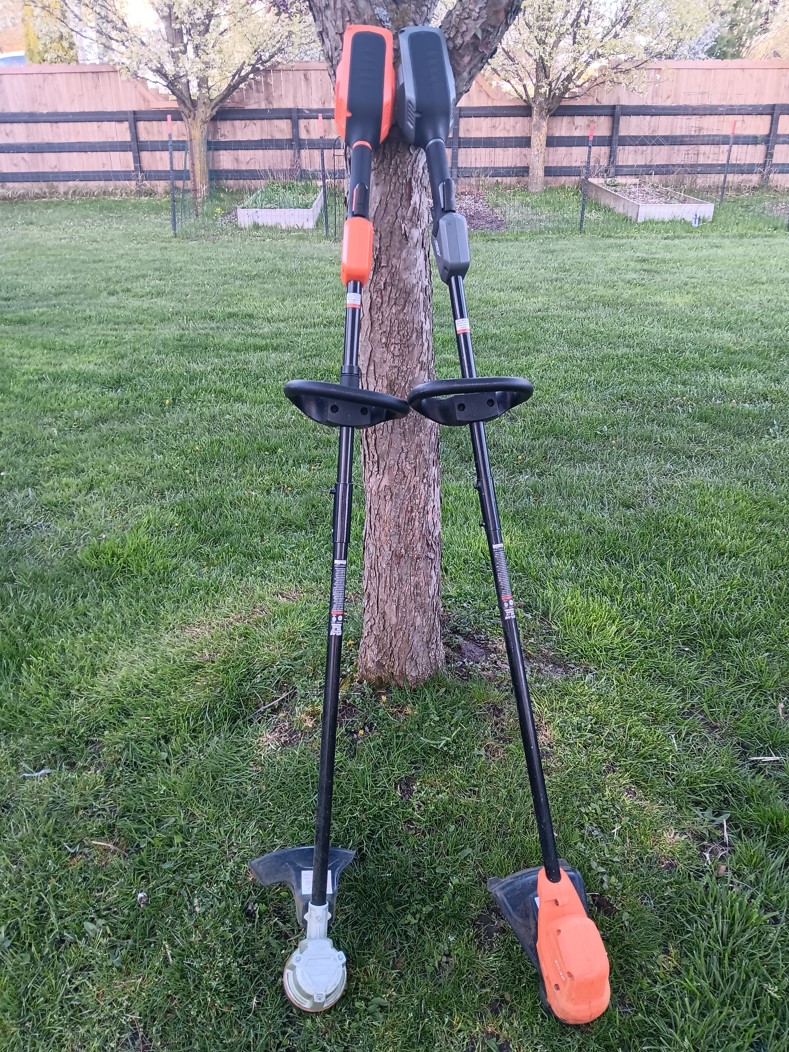
While the trimmers share similarities in operation, size, and weight, there’s a distinct difference in how they feel.
The biggest physical difference is the actual head at the business end. Both trimmers have the motor at the head where the string is located. Although the 40-volt trimmer head is plastic, it’s larger and has a heavier feal compared to the smaller, metal, 80-volt trimmer head. The smaller head on the 80-volt trimmer feels nimbler when moving around obstacles.
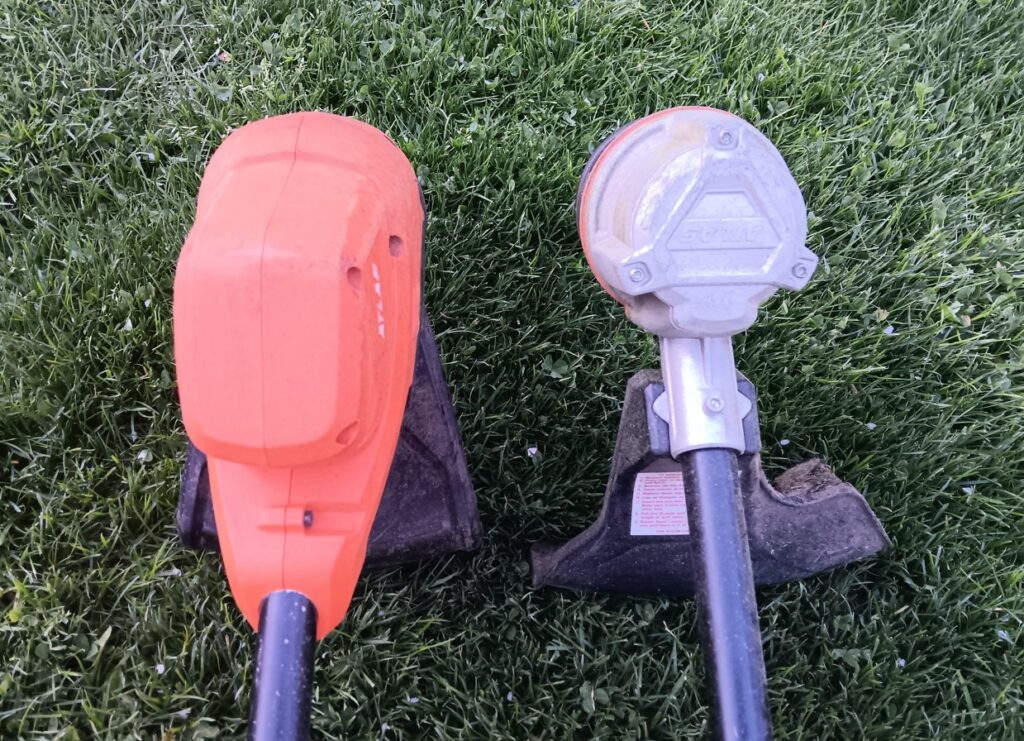
The balance point between the two is not the same as the 40-volt balances closer to the head and the 80-volt a little further back towards the battery end. This results in a heavier feel in the 40-volt for the arm supporting that end of the trimmer. This difference in balance is noticeable without the battery installed and also with the 40-volt battery. However, it is offset quite a bit if using the heavier 80-volt battery in the 40-volt trimmer.
The larger, heavier battery offsets the weight of the head and gives the 40-volt trimmer a more balanced feel. This can be an important consideration since a heavier feeling trimmer head can fatigue the supporting arm quicker. The 80-volt requires the larger battery and has a more balanced feel overall.
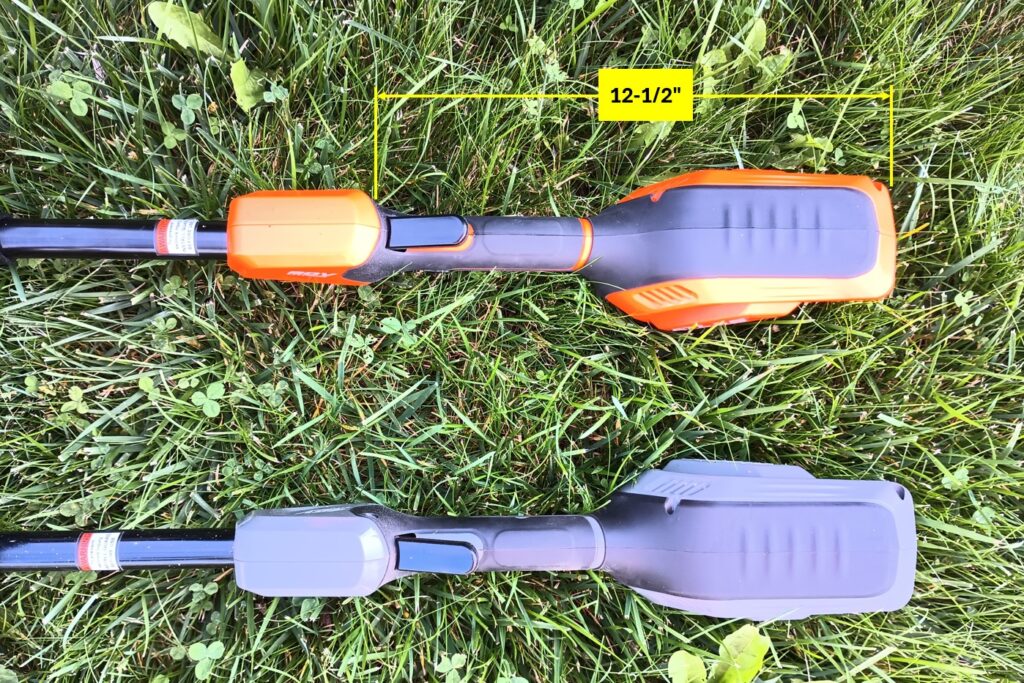
Once nice feature of both trimmers is the arm resting pad above the battery. In both cases the weight of the head is mitigated by the fact that the downward force of the head on one arm is countered by the battery pushing up on the other arm. So, the elbow/forearm near the battery is countering the head weight.
Spools
Both trimmers have similar looking spools. For the 40-volt trimmer Atlas recommends .080″ line and no more than 13 ft. in length. For the 80-volt it recommends .095″ line and no more than 10 ft. in length.
The manual has decent information on how to add new line but one tip we’ve learned is that the string typically loads much easier if the curve of the line is opposite of the feed into the trimmer head. This way the line tends to hug the outside of the trimmer head and feeds through smoother.
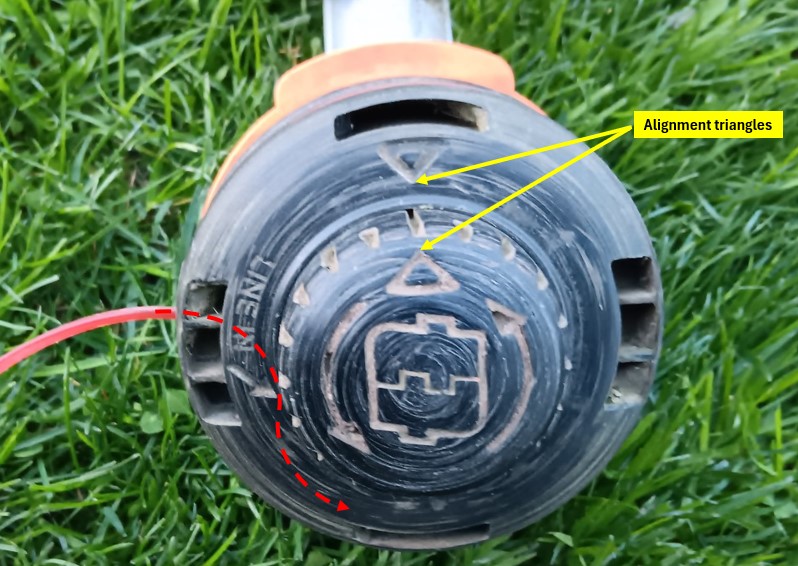
One last thing on loading the string into the spool, it does take a bit of hand grip strength to turn the knob on the spool to wind the string into the spool.
Runtime
The runtime in both trimmers is indistinguishable when using the 80-volt battery. With the 40-volt battery in the 40-volt trimmer the runtime is noticeably shorter than with the 80-volt battery.
Other Considerations
One of our initial considerations was cost, another being some skepticism if any battery powered outdoor tool would be adequate for our needs. The 40-volt tools we have are more than adequate for light to moderate use, however, our trimming tasks are more than light or moderate. Definitely not commercial use but the trimmer gets used pretty hard for home use. So, for us the 80-volt would have been the better initial purchase rather than the 40-volt even with the higher price tag of the trimmer. Once we liked the first trimmer we jumped in and picked the 80-volt battery for a longer runtime since the trimmer could use both. If you think you may get the 80-volt battery for the 40-volt trimmer, then consider just getting the 80-volt trimmer in the first place.
Size of the trimming job is also worth considering. As mentioned, the 40-volt trimmer itself performed well in harder tasks. If your trimming doesn’t include much more than tall grass then the smaller diameter line will most likely be just fine. Also, this setup may be less harsh on plants, trees, or wooden structures if the line happens to strike the object. I haven’t actually tested this, it’s more of an observation, but the smaller string seems to be more flexible and compliant, yielding to the object instead of hitting it harder.
Finally, if you are considering other tools in the Atlas lineup, then also consider which voltage makes sense for those tools as well. The push mowers for example are only available in 80-volt models.
Conclusion
If you require a trimmer for heavy-duty work and have a larger area to maintain, or lots of obstacles such as fences, rocks, raised beds, culverts, etc., then the Atlas 80-volt trimmer is likely the better choice. Its power and ability to use thicker string make it suitable for more challenging tasks. For those with smaller yards or lighter work, the Atlas 40-volt trimmer offers a lot in a more affordable package. Ultimately, the choice between the two will depend on your specific needs and how much you’re willing to invest. If you go with either one, hopefully you like it as much as we do ours.
